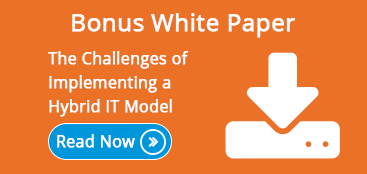 Application owners are facing a critical challenge – in order to meet the demands of innovation-hungry customers, IT leaders must quickly evaluate whether to re-architect their applications for the cloud, or develop new applications entirely.
Application owners are facing a critical challenge – in order to meet the demands of innovation-hungry customers, IT leaders must quickly evaluate whether to re-architect their applications for the cloud, or develop new applications entirely.
The need to bridge the gap between traditional IT and cloud-native applications is vital. Upgrading applications or developing new ones to run as “cloud-native” requires a broad set of new components to work together, an understanding of workload requirements, and a hybrid IT architecture that departs from traditional design.
Making the change to hybrid IT reduces risk and minimizes the time and money spent delivering business value. In some cases, organizations can reduce their costs by nearly 90 percent while improving software, quality, security, and compliance. However, there are some common challenges.
Common Challenges On The Road To Hybrid IT
Each enterprise navigates their own journey to hybrid IT and improving application delivery cycle time. Recognizing the development, operational, and infrastructure challenges that cloud-native architectures pose is the first step in addressing them. Here are four of the most common:
- Needing a way to incrementally evolve from monolithic applications that are holding the enterprise back.
- Needing the skills and tools for cloud-native development to eliminate risk and accelerate adoption.
- The current application release cycle is much too slow to respond to business demands.
- The current IT infrastructure is too inflexible to enable rapid change and deployment.
Overcoming The Obstacles To Find Success With Hybrid IT
HPE Pointnext released a blueprint for addressing each of these challenges. Together, their four “guiding principles” enable enterprises to reform the design-build-test-release-run cycle to be consistent with hybrid IT requirements.
1. Define the Right Application Architecture Based on Current Business Needs.
Capturing the application requirements is the first critical step in cloud-native development. Applications require services, monitoring, logging, and data persistence; they need to be architected for the cloud with a service-oriented approach, including the ability to scale horizontally, fail well, and provide a more seamless approach to SLA adherence utilizing cloud application techniques.
Next, assess the organization’s current application workloads, development model, release and product cycle, as well as the current infrastructure, capabilities, and future vision to determine the best fit architecture and appropriate microservices options.
Evaluate the composition and support of the application to deconstruct it into microservices. Map services to containers and select infrastructure platforms based on application lifecycle, update intervals, and compliance requirements. Base architecture choices on the trade-off between developer productivity and the expected application scaling ramp.
Establish initial guidelines and standards for the application architecture and update them based on what you learned from each sprint. Decide which open-source tools or vendor-based applications and toolsets are needed.
Expected Results:
- Applying value stream analysis will reduce cycle time to deliver innovative products and services.
- Conversion to microservices will reinvigorate legacy app investments by simplifying integration with new applications such as mobile, consumer facing applications.
- Applying lessons learned from pilot programs can yield cost reductions approaching 90 percent, while improving software quality, security and compliance.
2. Put in Place Tools and Skills to Transform and Operate New Hybrid IT Business Model.
Assess organizational needs and put in place the tools and skills necessary to transform to, and operate within, the new application development, release, and business model. Make sure the knowledge base, integration, automation steps, and build processes are all working together seamlessly.
Curate the best fit tools and technologies, including open source. Add more agile development tools and CI/CD processes. Provide training on these tools and coaching on best practices around items such as sprints, QA, build, test, and release processes.
Invest in management of change to lock in these processes, skillsets, tools, and development to ensure buy-in and success. Building out DevOps skills and organizational effectiveness training can help here.
Deploy a trial with a key business application and a small team. Evaluate lessons learned and have those team members lead new teams to propagate change organically.
Expected Results:
- An integrated toolchain, supported by training, simplifies delivery of new applications and services.
- Automation of operations ensures applications and code work as planned with each release and generates instant feedback.
- Pilot approach generates buy-in and enables changes to meet organizational requirements.
3. Move to Rapid Release Cycles Using Automation.
Structure the development environment to optimize developer efforts and reduce time spent producing code. Reducing manual steps and the cycle times between builds is essential to developer productivity and integrated development environments.
Evaluate current release processes and adapt to a better, more effective, and controlled cloud-native continuous driven release cycle with more reliable quality code. Accelerate the application delivery process and automate it. Evaluate current compliance and audit requirements and adjust accordingly with the cloud-native process.
Work with the organization and guide the automation procedures and steps based on their current processes and future requirements. Evaluate and implement orchestration and management engines and monitor their success.
Evaluate release history for significant error/failure events to prevent reoccurrence and apply this to the app release cycle and processes. Eliminate or correct any processes that introduced bad code.
Implement robust automation steps and procedures to handle the application release cycle. For example, allocating and reallocating containers, upgrades, and services. Evaluate performance, enhancing architecture, and infrastructure based on application needs as they happen. Automate repetitive processes to improve quality, auditability, and speed.
Expected Results:
- Deploying the CI/CD process yields faster time-to-market while maintaining compliance.
- Task orchestration engines will improve performance and developer productivity and enable more efficient collaboration across teams.
- Automation and integration of the development and test environment will reduce human error, risk, and cost.
4. Design, Recommend Infrastructure for Cloud, and Microservices Development.
Create and communicate changes to processes to minimize risk and improve the infrastructure. This approach will ensure platform performance, software availability, security, business continuity, and always-on capabilities are priorities.
Foster collaboration between applications and operations teams to jointly design the new infrastructure to accommodate the cloud-native and microservices development.
List performance requirements and use these with containers and platforms. Define the performance requirements and areas of improvement for taking traditional applications and converting to cloud. Also include infrastructure agility requirements - rapid provisioning, re-provisioning, and scaling.
Evaluate any hybrid IT migration plans to move legacy applications to a cloud-based application. Provide suitable applications, tools, and processes to support and monitor the production environment. Apply rapid recovery processes and synergies.
Define the right mix of infrastructure to accelerate time-to-value from applications and data. Typically, this means transforming to a hybrid IT environment. The right mix of infrastructure, defined to address core workload types, is key to simplifying operations, speeding up workloads, lowering costs, and heightening efficiency.
Expected Results:
- Focusing on risk management ensures optimized infrastructure and processes that align with core workloads.
- Coordination between supporting teams delivers an efficient, timely migration to the new environment.
- Planning for the right mix and key workloads will reduce infrastructure costs with faster deployment cycles.
Let WEI Help Guide Your Hybrid IT Transformation
Your enterprise needs to have systems that are as dynamic and innovative as its business and that can grow with you. By transitioning to hybrid IT, your organization can reduce expenses while improving software, quality, security, and compliance. Talk to a trusted IT solutions provider to learn how hybrid IT can fit into your IT strategy.
Next Steps: Stay ahead of your hybrid IT transition by downloading our white paper, “Overcoming the Challenges of Implementing a Hybrid IT Model.” Talk to a trusted IT partner to learn how hybrid IT can fit into your IT strategy.













